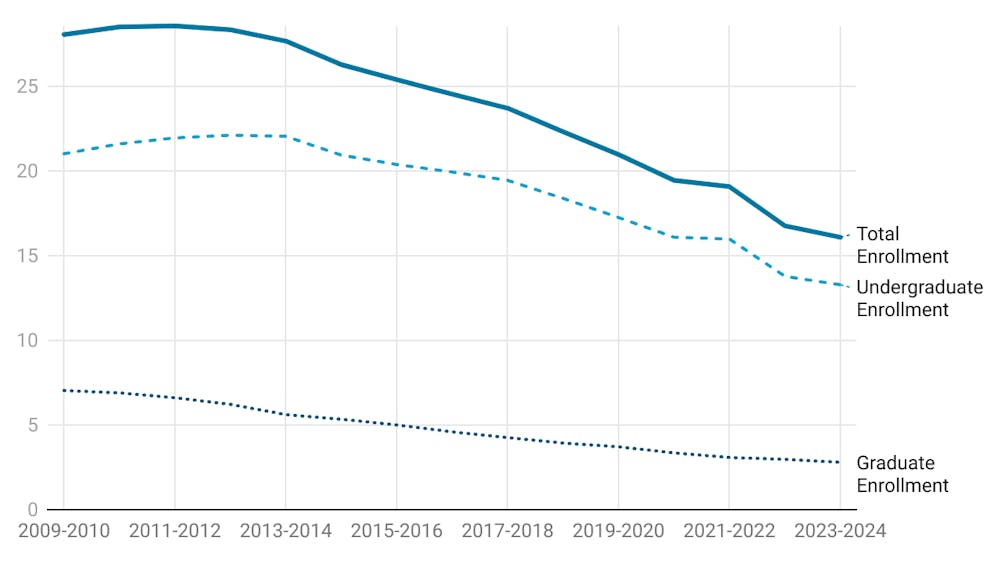Governor Snyder proposed a $36.2 million increase in appropriations to public universities in his budget proposal for fiscal year 2013 last Thursday. The money is to be distributed to Michigan’s 15 public universities.
Michael Boulus, director of the presidents council, state universities of Michigan, welcomed the increase in funding, but stressed that it must be viewed in context of the years of significant cuts to appropriations.
“It’s new money. We haven’t had new money in over a decade. But you’ve got to put it in perspective,” Boulus said. “It’s an OK start, but we were cut $218 million a year ago and a $1 billion over the last decade.”
Eastern Michigan is due to receive $1.5 million. This is less than 1 percent of EMU’s roughly $280 million operating budget.
Sue Martin, president of EMU, said she hopes that appropriations will continue to increase.
“Although this is a very positive first step for the state… that $36 million is only a small step toward restoring what was cut…We’ve got a long way before we even get back to where we were last year. We’d really hope that as tax revenues come in, if they’re stronger, that higher education be one of the first places that they would think about doing a larger increase than this,” Martin said.
“We would hope that we would begin to see the beginning of a story where we’re not just restoring what was cut but moving in the opposite direction to provide significant support.”
Continued significant increases were not forecast in Snyder’s budget proposal. In the governor’s recommendation for fiscal year 2014, he proposed an increase of roughly $2.7 million.
Representative David Rutledge of Washtenaw County also expressed dissatisfaction with the proposal, calling the
minimal increases to appropriations an extension of the cuts from previous years.
“This proposal would extend last year’s deep cuts to education, with only minor increases to public school districts, community colleges, and universities,” Rutledge said in his official statement. “The Governor also mentioned a new set of ‘best practices’ that schools will have to demonstrate before receiving full funding. Schools have more to worry about – like educating kids – than whether they will receive necessary resources from the state. We can’t expect Michigan to move forward without investing in education. And we can’t pretend that schools and communities aren’t hurting.”
As Rutledge pointed out, the increase for FY ‘13 is “performance funding.” According to the official Executive Budget Highlights, universities will receive funding “based on four factors: the three year average growth in the number of undergraduate completions; the three year average number of undergraduate completions in critical skills areas; the three year average number of undergraduates receiving a Pell Grant; compliance with tuition restraint, with the cap set at 4 percent.”
Roughly $9 million remains unallocated as a “tuition restraint fund.”
Martin criticized the governor’s current formula out of concern that it would give a fiscal advantage to schools that have increased tuition greatly in the past. She stressed that the fairest way to monitor tuition increases is in absolute dollars, instead of percentages.
“It’s 4 percent of a larger number for people who did larger increases than we did. They’ll be able to increase in absolute dollar terms for students and families a bill more than we will with a percentage,” Martin said. “I think it should be a dollar amount and a three-year average of your tuition increases rather than just one year.”
Boulus said he was comfortable with funding being distributed based on performance, but that the governor’s
formula is underdeveloped.
“We’re very comfortable with using performance metrics accountabilities to allocate new funding. However, I think the formula could probably use some work. It’s a look back over three years instead of a look forward. It doesn’t acknowledge graduate degrees and it doesn’t acknowledge where one might stand in comparison to their peers,” Boulus said. “I think it needs some work but overall the concept of tying dollars to performance is a good one.”
Boulus encouraged students to become involved in the budget discussion. He stressed that cuts to appropriations affect students most of all, by increasing demand for tuition-based revenue and threatening the quality of education.
“We’ve been cut over $3,000 per student just in the last decade. That’s the burden being placed on students and their parents,” Boulus said. “When we’re bottom 5 in state support, we’re not going to be able to sustain this model of quality and accessibility.”
Boulus suggested that any students looking to become involved seek out their local chapter of the Student Association of Michigan.
Martin speculated that legislators have continued to cut appropriations because it’s an easy way to balance the state budget. She said that universities have been unfairly blamed for the resulting tuition increases.
“I think it became an easy place to cut and they didn’t share ownership that when you cut, you force tuition increases,” Martin said. “Now we’re being pointed at, saying, ‘Well you raised tuition after all these years.’
Well you [legislators] reduced our funding from 70 percent of our operating budget to bouncing around 20 percent…what did you think would happen?”
Martin said that Michigan legislators ought to be more supportive of Michigan universities because the majority of them earned bachelor’s degrees from a public university in Michigan.
“It’s interesting, 75 percent of Michigan’s legislators have a 4-year degree from a public university in Michigan, as compared to nationally only 55 percent do,” Martin said. “So clearly they value what we do—they came here.”








